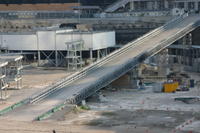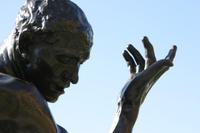Returning to Ground Zero
It is the eve of the fourth anniversary of September 11, the event that changed the world for many people and shifted the entire course of my life. In the aftermath of 9/11, I journeyed across America with my camera, documenting stories of hate violence against minority communities, including my own. Now four years later, I am a graduate student making a feature film about my journey. Still consumed by these stories and their questions, I traveled with my film crew to revisit Ground Zero on August 21, 2005…
I first visited Ground Zero in December 2001. I remember it well, the piles of rubble, the bent metal, the burning smell, the rain. And the people pressed up against police barricades, snapping pictures. I remember the nausea. Even then, retaliation was well under way.
 I returned there today. The ruins are gone, the site is wiped clean. There are wide open spaces now, white sidewalks, almost sterile. It is the result of many patient and persistent human hands, clearing rubble, recovering control, reconstructing a new vision. There were still people, but now there is enough space for them to wander, to read the timeline mounted on the bars of the fence, to photograph in comfort.
I returned there today. The ruins are gone, the site is wiped clean. There are wide open spaces now, white sidewalks, almost sterile. It is the result of many patient and persistent human hands, clearing rubble, recovering control, reconstructing a new vision. There were still people, but now there is enough space for them to wander, to read the timeline mounted on the bars of the fence, to photograph in comfort.
 I did not feel nauseous this time. I just felt blank, staring at the empty site, bewildered by what this event has done to us. What new war, what vast measures, and to what end. I could not comprehend it, so I thought of nothing.
I did not feel nauseous this time. I just felt blank, staring at the empty site, bewildered by what this event has done to us. What new war, what vast measures, and to what end. I could not comprehend it, so I thought of nothing.
But then I thought of the people I have met in the last four years, and there, filling the emptiness, appeared a mass of stories, a whirlwind of stories, hundreds of voices and faces. They were all there, dazzling and devastating, and each laid claim to the meaning of September 11:
At Ground Zero, a turbaned man gazes at the ruins. Minutes after running from the collapsing towers on 9/11, he was chased by men who called him a terrorist and ran for his life the second time that morning. He was the first of thousands of Americans who encountered hate violence after 9/11.
In a living room in Phoenix, a young boy begins to cry when remembering his uncle who was killed on September 15. He was the first of an estimated 19 people killed in post-9/11 hate crimes.
At a Ramadan dinner in San Francisco, a family sits quietly at the table. They are afraid to tell their story, but I know that their son is missing. He was one of 13,000 Muslim and Arab men deported or in deportation hearings for immigration violations since 9/11.
In an office in Washington, DC, a law school professor tells me about his new client, an 18-year old boy who has been imprisoned in Guantanamo Bay since 2001. He has been tortured. He is one of 520 boys and men still detained at Guantanamo Bay.
In a home in the SF Bay Area, an Afghan refugee woman sits beside me and cries into her hands. During battle with the Taliban, a bomb fell on her home and killed her husband and son next to her. Her husband is another death in the war on terror, 3,000 civilians killed in Afghanistan and 24,665 civilians killed in Iraq.
At a Harvard Square cafe, my friend tells me that two classmates from high school in Clovis, California have been killed in the war in Iraq. They are two of 1508 American soldiers killed in the war in Iraq.
On a street corner in San Francisco, a stranger on the street tells me her story in tears. She has kidney disease and will die without healthcare. She blames our current government. She is black and poor. Her story resonates with the plight of hundreds of thousands of victims of Hurricane Katrina, largely black and poor, who were withheld from resources concentrated elsewhere.
 All this violence still defies my comprehension, but I believe that there is redemption in hearing and retelling these stories. These people have endured TERRORISM, DISCRIMINATION, DETENTION, DISPLACEMENT, TORTURE, and WAR. Many of them live in ways invisible and unrecognizable to the public. Their suffering is not recognized, not dignified, not grievable.But when they tell their stories — when the Afghan widow weeps beside me, when the turbaned Sikh boy wants his uncle back, when the black woman wonders why no one cares – they make me see them, recognize them and remember them.
All this violence still defies my comprehension, but I believe that there is redemption in hearing and retelling these stories. These people have endured TERRORISM, DISCRIMINATION, DETENTION, DISPLACEMENT, TORTURE, and WAR. Many of them live in ways invisible and unrecognizable to the public. Their suffering is not recognized, not dignified, not grievable.But when they tell their stories — when the Afghan widow weeps beside me, when the turbaned Sikh boy wants his uncle back, when the black woman wonders why no one cares – they make me see them, recognize them and remember them.
Standing at Ground Zero, remembering each story, I began to see a common anguish. And I began to hear a common cry — THAT IT COULD BE OTHERWISE. We have the resources to build a state and society that does NOT persecute minorities in times of war, that does NOT allow the poor to suffer, that does NOT engender more violence. It is possible to work toward this common vision.
On this four-year anniversary, we can retell and remember the stories of people who died on September 11, and the people whose lives have been broken in its ongoing aftermath, and RESPOND in ways that stop cycles of violence, in big steps and small gestures, starting now.
My hope is that this film can be a small part of the solution.
(NOTE: This entry was updated on September 10, 2005, including the introduction and the note on Hurricane Katrina. Read the latest press release about the film.)


